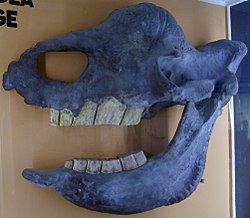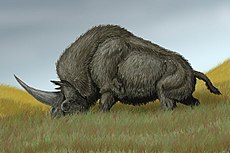Elasmotherium
Elasmotherium is an extinct giant rhinoceros.
| Elasmotherium Temporal range: late Pliocene to late Pleistocene, 2.6 mya – ~50 kya
| |
|---|---|

| |
| Elasmotherium skull | |
| Scientific classification | |
| Kingdom: | |
| Class: | |
| Order: | |
| Family: | |
| Genus: | Elasmotherium J. Fischer, 1808
|

It lived from 2.6 million years ago (mya) to about 50,000 years ago. Fossils have been found in Europe and Asia.[1] This giant lived and grazed on the Eurasian steppes (grasslands).
Description
changeElasmotherium was a heavily-built quadruped that walked on four hoofed legs. Its legs were longer than those of other rhinos and were adapted for galloping, giving it a horse-like gait.
It probably had a large horn on its forehead, but fossils of the horn have not been found. The teeth were tall-crowned and were covered with cement and wrinkled enamel. Its mouth at the front was a beak; there are no teeth in front of the molars.
Morphology
changeThe specimens of E. sibiricum are up to 4.5 m (15 ft) in body length with shoulder heights over 2 m (6 ft 7 in). E. caucasicum was at least 5 m (16 ft) in body length with an estimated mass of 3.6–4.5 tonnes (4–5 short tons). This is based on isolated molars which are larger than those of the Siberian species.[2]
Both species were among the largest in the family Rhinocerotidae, comparable in size to the woolly mammoth and larger than the woolly rhinoceros.[3][4] The feet were unguligrade,[5] the front larger than the rear, with 4 digits at the front and 3 at the rear.[6]
References
change- ↑ Tleuberdina, Piruza; Nazymbetova, Gulzhan (2010). "Distribution of Elasmotherium in Kazakhstan". In Titov, V.V.; Tesakov, A.S. (eds.). Quaternary stratigraphy and paleontology of the Southern Russia: connections between Europe, Africa and Asia: Abstracts of the International INQUA-SEQS Conference (Rostov-on-Don, June 21–26, 2010) (PDF). Rostov-on-Don: Russian Academy of Science. pp. 171–173. Archived from the original (PDF) on 2010-09-28. Retrieved 2013-06-08.
- ↑ Zhegallo V. et al 2005. On the fossil rhinoceros Elasmotherium (including the collections of the Russian Academy of Sciences). Cranium 22 (1): 17–40. [1] Archived 2014-08-10 at the Wayback Machine
- ↑ Cerdeño, Esperanza; Nieto, Manuel (1995). "Changes in Western European Rhinocerotidae related to climatic variations" (PDF). Palaeo (114): 328.
- ↑ Cerdeño, Esperenza 1998. Diversity and evolutionary trends of the Family Rhinocerotidae (Perissodactyla). Palaeo 141, 13–34. [2]
- ↑ Like horses, they walk on hooves, that is, on the tips of their toes or toe.
- ↑ Belyaeva, E.I. (1977). "About the hyroideum, sternum and metacarpale V bones of Elasmotherium sibiricum Fischer (Rhinocerotidae)" (PDF). Journal of the Palaeontological Society of India. 20: 10–15.